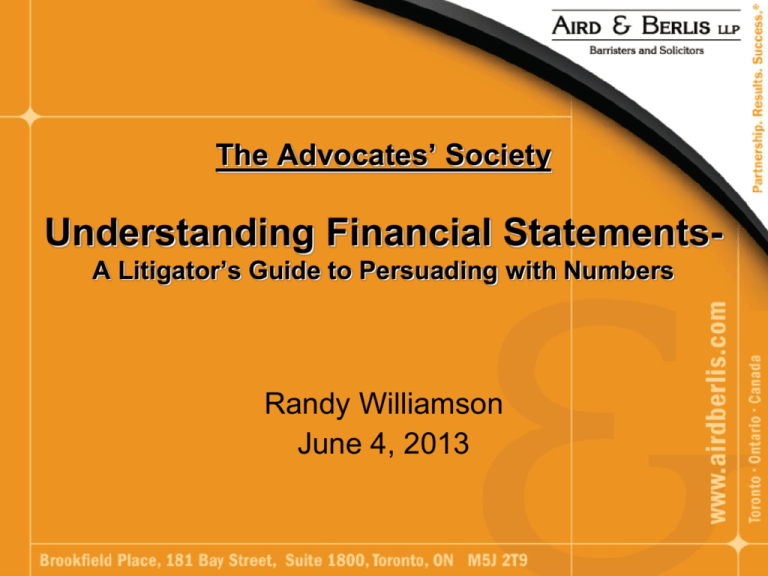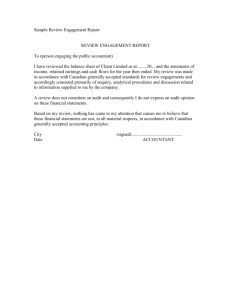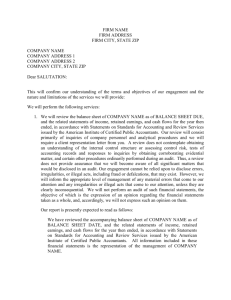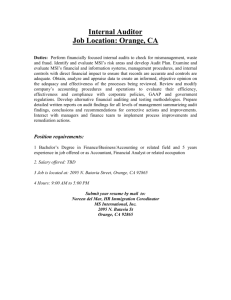The Advocates' Society Understanding Financial
advertisement

The Advocates’ Society Understanding Financial StatementsA Litigator’s Guide to Persuading with Numbers Randy Williamson June 4, 2013 “It has passed into a proverb that solicitors are the worst accountants, and … the accountant makes a very bad lawyer. The action of the solicitor’s ingenious and subtle mind is naturally adverse in its operations from the sharp and rapid action of the vivid and concentrative mind of the accountant. Both sets of qualities are seldom to be found in one brain, and there is little risk of the two running against each other if care be exercised in their professional practice … To dabble in law should be utterly renounced by accountants, and to dabble in accounts should be completely renounced by solicitors” October 1874, The Accountant 2 Reading and Understanding Financial Statements • Why it Matters • Users and Uses • Types of Financial Information • Statement Elements, Management Responsibility • Limitations and Auditor Involvement • Basic Financial Statement Ratios & Uses • GAAP Reporting Landscape • Conclusions 3 Why it Matters • Most disputes between commercial litigants intend to achieve a financial result • Assessing financial information at a high level may help determine claim viability • May also help identify further analyses or expertise required • Financial statements may offer key information necessary to resolve dispute 4 Users and Uses • Management and Employees • Employers and Owners • Lenders and Creditors • Analysts and Regulators (e.g. CRA, Competition Bureau, Investment Canada director) • Investors and Acquirers • Receivers/Monitors Understanding how users use financial information can help determine what information is relevant to a dispute 5 Types of Financial Information • Annual Consolidated Financial Statements • Annual Reports, MD&A • Quarterly Statements • Combined, Unconsolidated • Tax-based financial reports • Unaudited, Internal operating information • Budgets & Forecasts (e.g. for financings) • Special Purpose and Compliance Reports (e.g. contractual, bank requirements) 6 Financial Statement Elements • Balance Sheet • Statement of Operations / Income Statement • Statement of Shareholders’ Equity • Statement of Cash Flows • Notes • Accounting Policies – statement presentation basis, choices • Other Material Disclosures - e.g. commitments and contingencies, litigation, related party dealings, etc. • Management Responsibility 7 Management’s Responsibility for Financial Statements The accompanying financial statements are the responsibility of management. The financial statements have been prepared in conformity with Canadian generally accepted accounting principles using management’s best estimates and judgments based on currently available information, where appropriate. Management is also responsible for a system of internal controls which is designed to provide reasonable assurance that assets are safeguarded, liabilities are recognized and that financial records are properly maintained to provide timely and accurate financial reports. The Board of Directors is responsible for ensuring that management fulfills its responsibility in respect of financial reporting and internal control. The Audit Committee of the Board, which is comprised solely of unrelated and outside directors, meets regularly to review significant accounting and auditing matters with management and the independent auditors and to review the interim and annual financial statements. The financial statements have been audited by John Smith, the independent auditor, in accordance with Canadian generally accepted auditing standards on behalf of the shareholders. The Auditors’ Report outlines the nature of his examination and his opinion on the financial statements. John Smith has full and unrestricted access to the Audit Committee to discuss his their audit and related findings as to the integrity of the financial reporting. William Johnson President and CEO Susan Jones, C.A. Chief Financial Officer 8 Financial Statement Limitations • Mostly reflects historical details – not present values or how the future may affect enterprise • Dependent on input information upon which it’s based – not all items reflect their fair value • Policies, judgments, estimates – different enterprises, even in same industry, may account for the same items differently • May not allow for effective comparison between enterprises, industries, even different time periods • Auditor or outside accountant involvement and assurance may increase comfort with information 9 Auditor / Accountant Involvement • Auditor Responsibility and Limits • Audited Statement (“present fairly, in all material respects”) • Notice to Reader (“compiled statements”) • Reviewed (“nothing came to our attention”) • MD&A, Annual Reports • Public Offering & Disclosure Documents 10 Audit Report I have audited the consolidated balance sheets of ABC Limited as at December 31, 2012 and the income and cash flow statements for the period then ended. These financial statements are the responsibility of the company’s management. Our responsibility is to express an opinion on the financial statements based on our audits. I conducted my audit in accordance with Canadian generally accepted auditing standards. Those standards require that I plan and perform an audit to obtain reasonable assurance whether the financial statements are free of material misstatement. An audit includes examining, on a test basis, evidence supporting the amounts and disclosures in the financial statements. An audit also includes assessing the accounting principles used and significant estimates made by management, as well as evaluating the overall financial statement presentation. In my opinion, these financial statements present fairly, in all material respects, the financial position of ABC Limited as at August 31, 2010 and the results of its operations and its cash flows for the period then ended in accordance with Canadian generally accepted accounting principles. Toronto, Canada June 4, 2013 John Smith, C.A. (Note – underlining emphasis added) (Note – U.S. companies include an Audit Report on Internal Control over Financial Reporting) 11 Notice to Reader / Review Report Notice to Reader I have compiled the balance sheet of ABC Limited as at December 31, 2012 and the statements of income, retained earnings and cash flows for the period then ended from information provided by management. I have not audited, reviewed or otherwise attempted to verify the accuracy or completeness of such information. Readers are cautioned that these statements may not be appropriate for their purposes. Review Report I have reviewed the balance sheet of ABC Limited as at December 31, 2012, and the statements of income, and retained earnings and cash flow for the period then ended. Our review was made in accordance with Canadian generally accepted standards for review engagements and, accordingly, consisted primarily of enquiry, analytical procedures and discussion related to information supplied to us by the company. A review does not constitute an audit and consequently I do not express an audit opinion on these financial statements. Based only on my review, nothing has come to my attention that causes me to believe that these financial statements are not, in all material respects, in accordance with Canadian generally accepted accounting principles. (Note – underlining emphasis added) 12 Basic Financial Statement Ratios • Balance Sheet – Asset Intensity / Availability Measures • Working Capital, Quick Ratios • Debt/Equity Ratio • Income Statement – Business Profitability Measures • Gross Margin, EBITDA, Pre-tax Income, Net Income • Mixed Ratios – Cash Flow, Capital Intensity Measures • Debt Service, Fixed Charge Coverage Ratios • Return on Asset, Equity • Management Ratios – Operating Measures • Days Sales in Receivables, Inventory Turnover • Backlog, “Booked to Billed”, Sales Wins ratios 13 Use of Ratios • Point in time ratios are of limited use • More useful to signal important trends, or to make comparisons to benchmarks • Ratio analysis reflects quality of underlying financial information • Different enterprises may use different inputs • Depends on people providing it - knowledge, sophistication, detail • Makes comparison across enterprises or industries challenging 14 GAAP Reporting Landscape • From January 1, 2011, Canadian GAAP as we knew it ceased to exist • All Canadian enterprises were required to change • IFRS – International Financial Reporting Standards • Applies to “Publicly Accountable Enterprises” • Likely resulted in increased note disclosure – potentially more useful information for review • ASPE - Accounting Standards for Private Enterprise • Intended to simplify some reporting for enterprises whose financial statement readers require less detail • Use of multi-year financial statements may require reconciliation of information that used ‘old’ GAAP 15 Conclusion • Consider relevant financial information for the dispute on which you are advising • Understand role that auditor/accountant played to assess the financial statements, perhaps giving some comfort on reasonableness of information • Understand limitations inherent in the financial information you are considering, including on ratios • BUT, don’t try to be an accountant! Reach out to appropriate experts for detailed analysis of financial information in dispute! 16 Thank You Randy Williamson Aird & Berlis LLP Brookfield Place, 181 Bay Street Suite 1800, Box 754 Toronto, Ontario M5J 2T9 Canada E rwilliamson@airdberlis.com T 1.416.865.7705 F 1.416.863.1515 www.airdberlis.com








